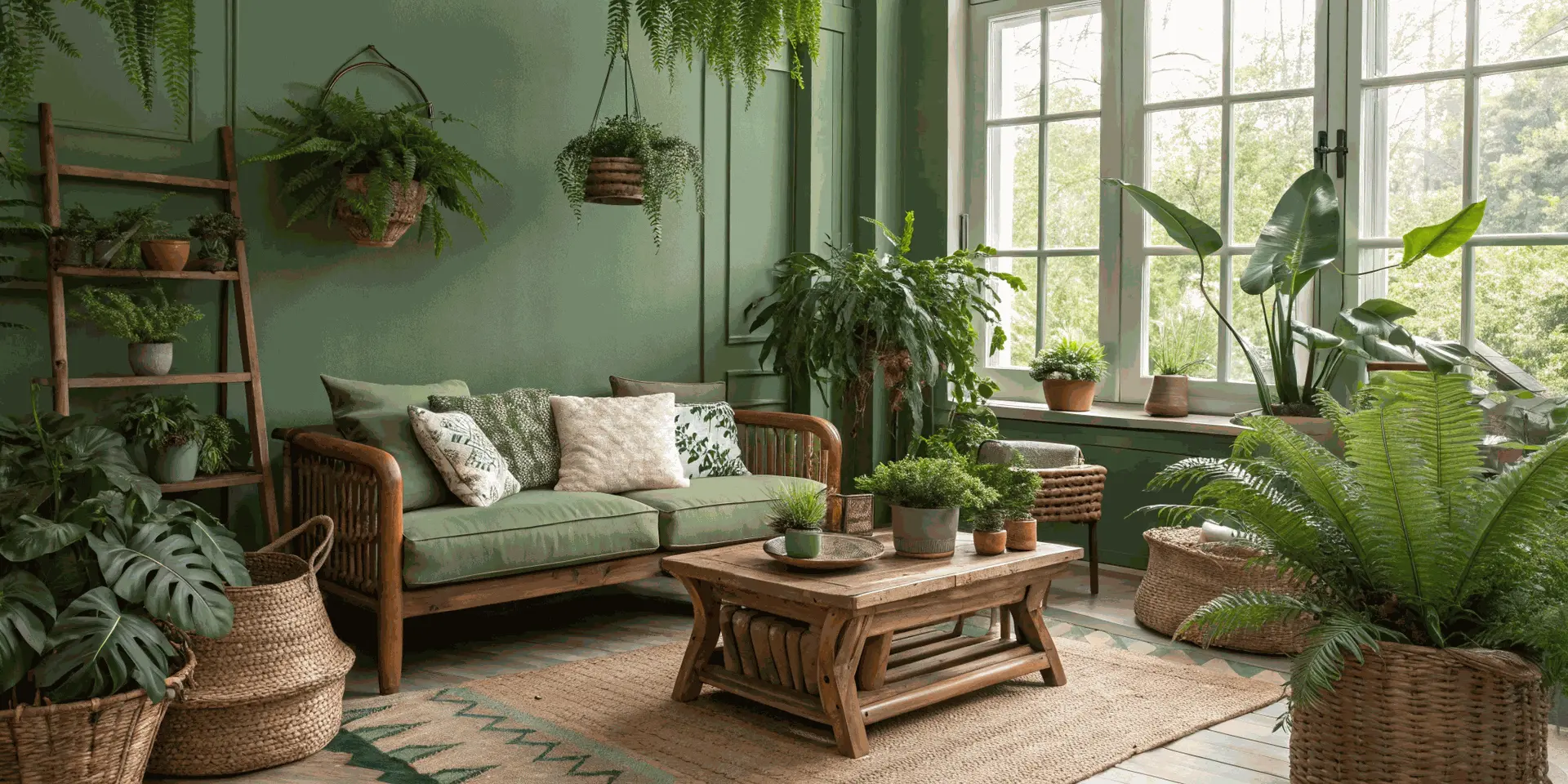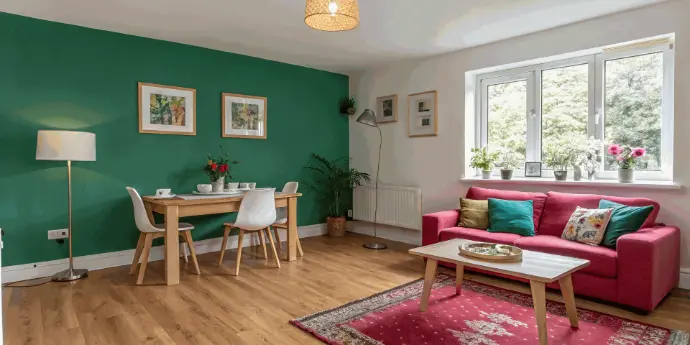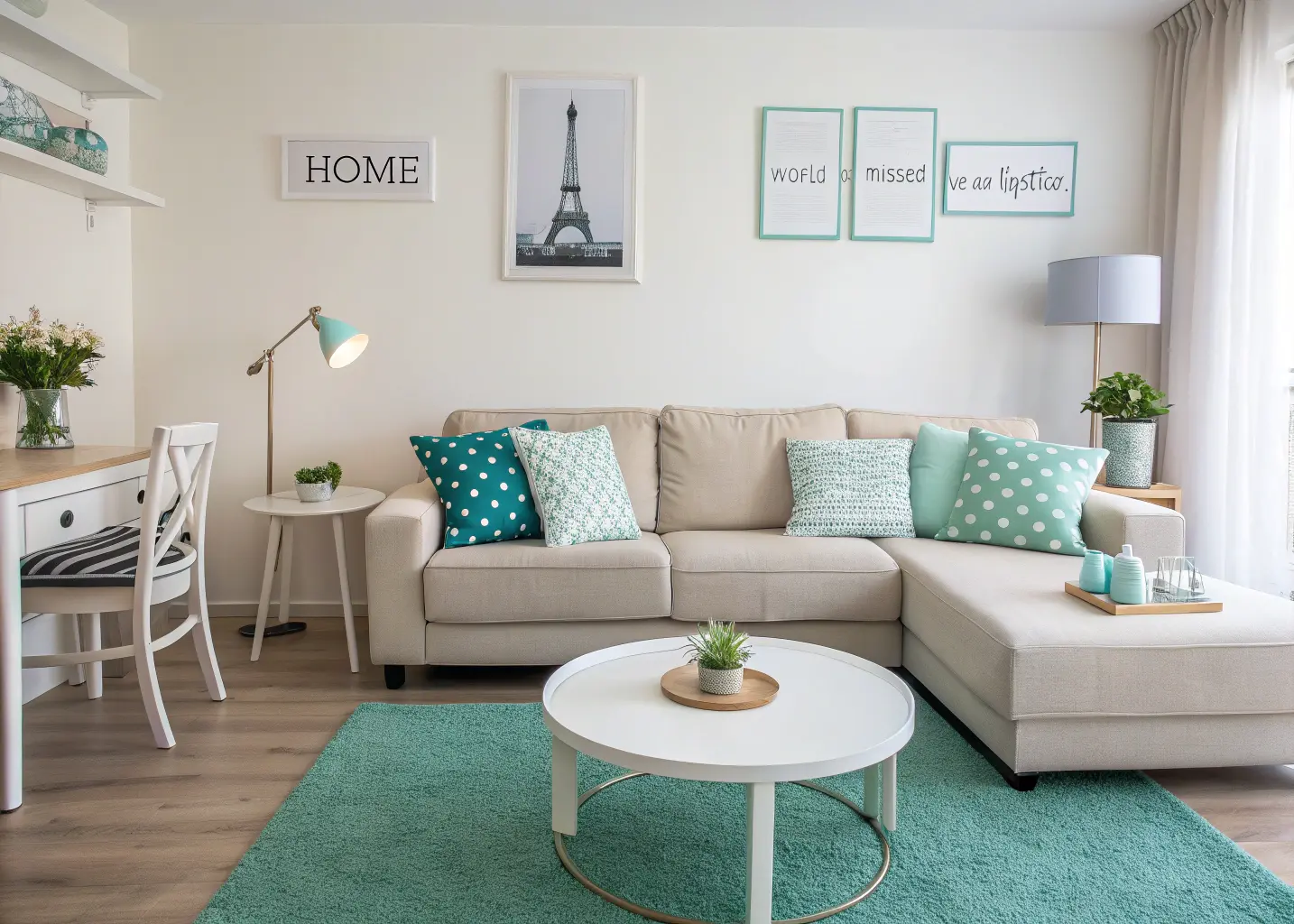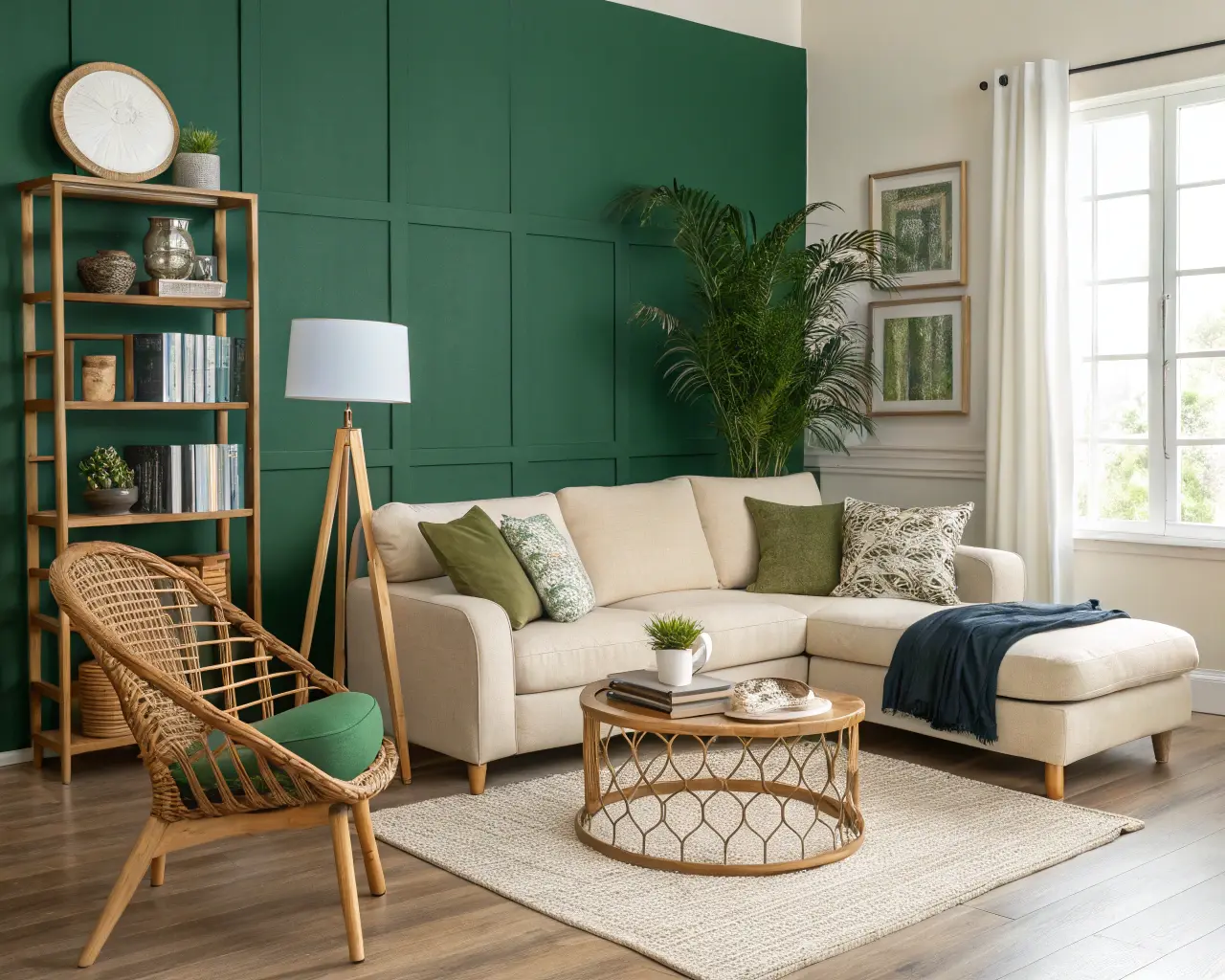Green Living Room Ideas: Crafting an Eco-Friendly Haven
The living room, the heart of your home, should be a sanctuary – a place of relaxation, connection, and rejuvenation. But what if it could be even more than that? What if your living room could also be a haven for sustainability and well-being? Embracing green living room ideas allows you to create a space that is not only aesthetically pleasing but also environmentally responsible and beneficial for your health.
In an era where sustainability meets style, transforming your living room into a green sanctuary is more than a trend—it’s a lifestyle. A 2021 report by the Global Wellness Institute revealed that 78% of homeowners now prioritize eco-friendly materials when renovating, reflecting a seismic shift toward conscious living. A green living room not only reduces your environmental footprint but also creates a serene, health-conscious space for relaxation and connection. This guide dives deep into actionable, stylish ideas to help you design an eco-friendly living room that aligns with your values without compromising on aesthetics.
Why Go Green? The Benefits of an Eco-Conscious Living Room
The decision to embrace a green living room extends far beyond aesthetics. Conventional home decor often relies on synthetic materials, chemical-laden paints, and energy-intensive practices that harm both the planet and personal well-being. By opting for sustainable alternatives, you invest in a space that nurtures health, ethics, and long-term savings.
Studies by the Environmental Protection Agency (EPA) highlight that indoor air can be up to five times more polluted than outdoor air, largely due to volatile organic compounds (VOCs) emitted by traditional paints and furniture. Switching to low-VOC paints and natural materials like organic cotton or reclaimed wood slashes toxin levels, creating a safer environment for families, especially those with allergies or asthma. Beyond health, sustainable choices support ethical labor practices. For instance, Fair Trade-certified furniture ensures artisans receive fair wages, while FSC-certified wood guarantees responsible forestry.
Financially, energy-efficient upgrades like LED lighting and smart thermostats can reduce utility bills by 20–30%, according to ENERGY STAR. Moreover, natural materials such as bamboo flooring or hemp textiles age gracefully, resisting the wear-and-tear that plagues synthetic alternatives. In essence, a green living room isn’t just a design choice—it’s a commitment to a healthier, more equitable future.
The Psychology of Green in Design
In color psychology, green symbolizes balance and harmony, serving as a bridge between warm and cool tones. Darker forest greens create intimate, grounded spaces ideal for traditional libraries or moody media rooms, while pale mint and sage tones maintain airy openness in sunlit areas.
Strategic Shade Selection
| Shade Intensity | Design Impact | Ideal Pairings |
|---|---|---|
| Pale Sage | Airy, relaxed | Blush pink, cream |
| Emerald | Dramatic | Gold, marble |
| Olive | Earthy | Terracotta, walnut |
| Dark Hunter | Cozy | Mustard, brass |
Mid-tones like basil green work well with black-and-white contrasts, while pastel mints complement warm metallics in Scandinavian-inspired spaces.
Earthy Color Palettes: Nature’s Hues on Your Walls
Color is the soul of any living room, setting the mood and reflecting personal style. Earthy tones like sage green, terracotta, and warm taupe dominate green interiors, evoking the tranquility of nature. However, sustainability begins with the paint itself.
Traditional paints are notorious for releasing VOCs, which contribute to respiratory issues and environmental degradation. Opt instead for low-VOC or zero-VOC options from brands like Benjamin Moore’s Natura or Sherwin-Williams’ Harmony line. These paints offer rich, durable finishes without compromising air quality. For a textured, artisanal look, consider natural clay or limewash paints. These breathable alternatives regulate indoor humidity, preventing mold growth and creating a rustic charm.
When selecting shades, draw inspiration from the outdoors. Soft greens like sage or seafoam instill calmness, making them ideal for walls. Warm neutrals such as oatmeal or terracotta ground the space, while deep forest green or navy accents add depth. For a cohesive look, test samples in different lighting conditions and pair them with natural wood or stone textures.
Edward Bulmer’s ‘Invisible Green’—a deep, leafy hue—has graced the walls of Rita Konig’s County Durham farmhouse and author Andrew O’Hagan’s Primrose Hill studio. This shade exudes confidence while maintaining timelessness, proving ideal for spaces that blend boldness with heritage. For softer atmospheres, Farrow & Ball’s ‘Breakfast Room Green’ or ‘Cooking Apple Green’ infuse rooms with a light, dusty elegance. In Francesca Gentilli’s 18th-century farmhouse, this gentle green complements pink and red upholstery, while its paneled walls cast delicate shadows, creating dynamic visual depth.
Sustainable Materials: From Floor to Ceiling
The foundation of a green living room lies in its materials. Prioritize renewable, recycled, or reclaimed options that minimize waste and resource consumption.
Flooring Choices
Bamboo stands out as a star material due to its rapid renewability—it grows up to three feet per day—and durability. Ideal for high-traffic areas, bamboo flooring resists scratches and comes in varied finishes. Cork, harvested from the bark of cork oak trees without harming the plant, offers a soft, sound-absorbent surface with natural antimicrobial properties. For a rustic touch, reclaimed wood salvaged from barns or factories adds character while reducing deforestation.
Furniture & Textiles
One of the most impactful ways to create a green living room is by choosing sustainable furniture. Opt for pieces made from renewable materials such as bamboo, reclaimed wood, or recycled metal. These materials not only reduce waste but also support eco-friendly manufacturing practices.
When selecting furniture, seek FSC-certified wood or brands like Medley or Avocado that prioritize organic, non-toxic materials. Upholstery matters too: organic cotton and hemp fabrics avoid pesticides and synthetic dyes, making them safer for skin and the environment. Vintage or upcycled pieces also shine here. A mid-century modern sofa reupholstered in organic linen, or a refurbished antique bookshelf reduces demand for new resources and adds unique charm.
Tips for Choosing Eco-Friendly Furniture
- Look for Certifications: Ensure your furniture is certified by organizations like the Forest Stewardship Council (FSC) or the Sustainable Furnishings Council (SFC).
- Avoid Harmful Chemicals: Choose furniture free from volatile organic compounds (VOCs) and other harmful chemicals.
- Support Local Artisans: Buying locally made furniture reduces transportation emissions and supports your local economy.
Decor Accents
In addition to furniture and flooring, sustainable decor can enhance the eco-friendliness of your living room. Opt for decor items made from natural or recycled materials, such as wool rugs, organic cotton throw pillows, or reclaimed wood wall art.
Recycled glass vases, such as those from West Elm’s Recycled Glass Collection, blend elegance with sustainability. Jute or sisal rugs, biodegradable and durable, introduce texture while aligning with eco-values. For artwork, consider pieces made from reclaimed metal or sustainably sourced paper.
Energy Efficiency: Smart Solutions for a Greener Space
Reducing energy consumption doesn’t mean sacrificing comfort. Strategic upgrades can transform your living room into an efficiency powerhouse.
1. Lighting Innovations
Maximize the use of natural light in your living room. Arrange your furniture to take advantage of windows and consider using sheer curtains to let in more light. Natural light not only reduces the need for artificial lighting but also enhances the overall ambiance of your space.
Swap incandescent bulbs for LEDs, which use 75% less energy and last 25 times longer. Enhance natural light with sheer curtains or strategically placed mirrors that amplify sunlight. For statement lighting, seek fixtures made from recycled materials, like pendant lamps crafted from reclaimed wood or glass.
2. Climate Control
Thermal curtains lined with insulating materials like wool or recycled polyester retain heat in winter and block UV rays in summer. Pair these with a smart thermostat like Nest or Ecobee, which learns your schedule and adjusts temperatures automatically, cutting energy use by up to 15%.
3. Eco-Conscious Appliances
If your living room houses entertainment systems, opt for ENERGY STAR-rated TVs and soundbars. These devices meet strict efficiency guidelines, reducing standby power consumption. For a holistic approach, consider solar-powered charging stations for devices or lamps.
Indoor Plants: Breathe Life into Your Space
Plants are the heartbeat of a green living room, purifying air, reducing stress, and bridging the gap between indoors and outdoors. NASA’s Clean Air Study identified several species that excel at removing toxins: the snake plant filters formaldehyde, the peace lily combats ammonia, and the spider plant neutralizes benzene.
For small spaces, vertical gardens mounted on walls or trellises maximize greenery without sacrificing floor space. Mix plant sizes for visual interest—pair a towering fiddle-leaf fig with trailing pothos in hanging planters. Herbs like basil or mint in repurposed tin cans add fragrance and functionality.
Benefits of Indoor Plants
- Air Purification: Plants absorb carbon dioxide and release oxygen, improving indoor air quality.
- Mental Health: Studies have shown that being around plants can reduce stress and improve mood.
- Aesthetic Appeal: Plants add a pop of color and texture to your living room, enhancing its visual appeal.
DIY & Budget-Friendly Green Ideas
Sustainability needn’t break the bank. Creativity and resourcefulness can yield stunning results.
Refresh thrifted furniture with non-toxic chalk paint or natural wood stains. An old ladder becomes a rustic bookshelf; wine crates transform into modular storage. For decor, forage for pinecones, driftwood, or stones to create natural centerpieces. DIY terrariums in mason jars or upcycled glass containers introduce greenery with minimal cost.
Sustainable Implementation Strategies
Eco-conscious material choices elevate green living rooms environmentally:
- Weaver Green’s Hammam Throw (300 recycled bottles per piece)
- KONK!’s solid oak shelving using traditional joinery
- Armadillo & Co’s wool-blend Sierra Rug with non-toxic dyes
Maintaining Your Green Living Room
Preserve your eco-efforts with mindful habits. Clean surfaces using vinegar, baking soda, or brands like Branch Basics that avoid synthetic chemicals. Integrate discreet recycling and compost bins beneath consoles to streamline waste management. Refresh air naturally by opening windows daily, and use essential oil diffusers instead of aerosol sprays.
Green Living Room Design Styles
Let's look at some examples to spark your imagination:
- The Minimalist Green Living Room: Features a neutral color palette, simple furniture made from reclaimed wood, and minimal décor. Indoor plants add a touch of natural beauty. Pair matte green walls with streamlined oak furniture and geometric linen cushions.
- The Bohemian Green Living Room: Incorporates vibrant colors, eclectic patterns, and natural textures. Furniture is a mix of vintage and handmade pieces.
- The Modern Green Living Room: Features clean lines, sleek furniture made from sustainable materials, and energy-efficient lighting. Indoor plants are strategically placed to add a touch of nature.
- The Coastal Green Living Room: Emphasizes natural light, airy fabrics, and a color palette inspired by the ocean. Furniture is made from natural materials such as rattan and bamboo.
Greem Living Room Layouts
The arrangement of your furniture can actually contribute to the sustainability of your space:
Multifunctional Spaces
Design your living room to serve multiple purposes, reducing the need for additional rooms and furniture. Consider modular seating that can be reconfigured for different activities, or ottomans that provide both seating and storage.
Flow Optimization
Arrange furniture to allow for easy movement throughout the space, making your room feel larger and more functional without requiring additional square footage.
Connection to Outdoors
If possible, position seating to take advantage of outdoor views. This visual connection to nature can improve wellbeing while reinforcing the sustainable ethos of your green living room.
Green Living Rooms in Action
- The Carters of Portland, Oregon, transformed their living room with bamboo shades, a reclaimed oak coffee table, and 15 air-purifying plants. By switching to LEDs and a smart thermostat, they cut energy bills by 25%.
- Decorator Benedict Foley revitalized Max Hurd’s London home with Farrow & Ball’s ‘Sap Green’ walls and ‘Bancha’ woodwork, proving that bold greens can evoke both tradition and whimsy.
- Designer Nina Litchfield’s Paint & Paper Library ‘Hunter Dunn’ bookshelves showcase how accent greens can highlight colorful decor without overwhelming a space.
Overcoming Challenges in Creating a Green Living Room
While the benefits are clear, implementing eco-friendly living room ideas can present challenges:
- Cost: Sustainable materials and energy-efficient appliances can sometimes be more expensive than conventional options. To mitigate this, prioritize key areas and gradually upgrade over time. Look for sales and discounts. Consider secondhand options.
- Availability: Finding sustainable furniture and décor items can sometimes be challenging, especially in certain areas. Shop online, support local artisans, and visit eco-friendly stores.
- Finding the Right Balance: Creating a green living room that is both stylish and sustainable requires careful planning and consideration. Find the right balance between aesthetics, functionality, and environmental responsibility.
Your Green Oasis Awaits
Designing a green living room is a journey of intentionality and creativity. Each choice—whether a coat of clay paint or a vintage armchair—contributes to a healthier home and planet. Start small: adopt one tip from this guide, then gradually expand. Share your progress on social media with #EcoChicLiving to inspire others. Together, we can redefine luxury as spaces that honor both people and the planet.
Share your green living room transformation using #SustainableHomeGoals for a chance to be featured in our eco-design spotlight.





Green Living Room Ideas